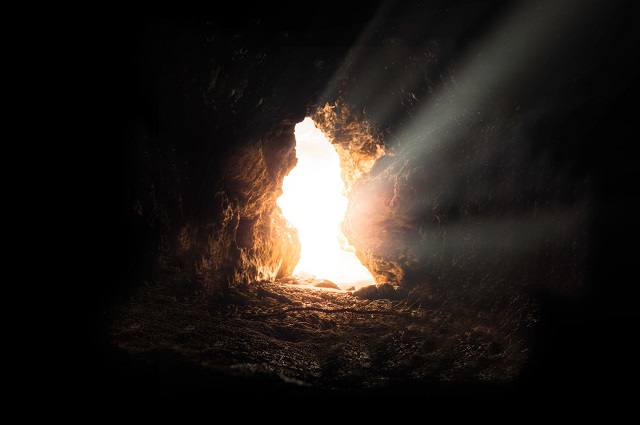Commentary on Luke 24:1-12
In Luke 24, we arrive at the empty tomb, one of the most beloved scenes in all of Christian literature.
So familiar has this scene become, in fact, that preachers might understandably wonder how to “proclaim the good news, which for many is neither new nor good.”1 What’s more, COVID-19 and worldwide quarantines have given rise to memes and mottos lauding new life: we will emerge from our COVID cocoons like butterflies, we will rise from the ashes of grief like the phoenix, we will enter post-COVID life as “new and improved” versions of our pre-COVID selves. The image of resurrection is so susceptible to cliché.
Is there anything new or good to say about the gospel, the “good news” of the empty tomb?
One illuminating theme of this Lukan passage is Jesus’ shifting forms of presence and absence. Typically, we think of “presence” and “absence” as opposites. When a teacher takes roll call in school (online or in-person), the student is either present or absent. Whether we will be paid for our labor at work depends on whether we show up or not.
However, this strict present/absent binary does not always stand up to scrutiny. We have all experienced when someone is physically present, but mentally absent (we might ask, “Where’d you just go?”), or vice-versa, when someone is not literally present, but we somehow sense their presence with us. Sometimes we tell people, “I can’t be there, but I’ll be with you in spirit.” The past year’s increase in Zoom and other online meetings has complicated our culture’s notions of presence and absence, as we simultaneously join people from around the world in digital spaces, or keep our computer cameras off but assure others that we are, in fact, present and listening. What does it mean in this era to be “here with” others?
At the start of Luke’s empty tomb scene, a group of faithful female disciples whom we know from earlier in the Gospel—Mary Magdalene, Joanna, Mary the mother of James, and “other women” (24:10)—go to the tomb with spices which they have prepared to pay their respects. They have a completely predictable, if gut-wrenching, job to do, one they have likely done many times before. Yet, to their great surprise, the women do “not find the body of the Lord Jesus” (24:3). Jesus is absent. Most of us are desensitized to how utterly shocking this must have been: if anyone should be present in a particular place, it would be a dead body in its tomb. But Jesus’ body is missing.
Still, Jesus’ absence unexpectedly points to his presence in a new way. Two angelic messengers, echoing Jesus’ own prediction in Luke 9:22, urge the women not to fear, to remember that this is not as unpredictable as it might seem: “Remember how he told you, while he was still in Galilee, that the Son of Man must be delivered into the hands of sinful men, and be crucified, and on the third day rise again” (24:6-7).
Notice that this is the first time in Luke’s Gospel that we hear of Jesus’ resurrection. Luke never describes God raising Jesus from the dead; instead of narrating the event itself, the author tells his audience about the resurrection through a series of spoken testimonies. First, the messengers meet the women and remind them of Jesus’ own spoken testimony. As a result, “the women remembered his words” (24:8). Their memory of what Jesus said when he was present before prompts them to go “tell all these things” to the eleven (the twelve apostles, minus Judas; 24:9). Whereas the male disciples do not initially believe, the women understand correctly that Jesus’ absence from the tomb means he is present on earth again. Church tradition has dubbed these women “the apostles to the apostles” (the official name is: quae apostoli ad apostolos).
In fact, the male disciples do not go to the tomb at all until the women testify to what they have witnessed. They may have believed that caring for Jesus’ dead body was “women’s work.” Even so, they could have gone to the tomb to mourn their fallen leader. When they hear the news from the apostles to the apostles, they still do not believe. The men think the women’s proclamation of the empty tomb is “empty talk” (a pejorative term, like “silly gossip” or “fake news”; 24:11). They misunderstand Jesus’ missing body, thinking it represents an absolute absence; even Peter, who runs to the tomb to see for himself, simply “wonders what happened” (24:12), a response about which Jesus later questions him (24:25-31).
What I want to highlight is that Jesus’ absence from the tomb creates the opportunity for the women to speak boldly and faithfully on his behalf, and they do. Their proclamation that Jesus is present—he is alive on earth again—is an act of redemptive remembering, in two senses: their remembering is a recalling of Jesus’ earlier teachings, but it is also a remembering insofar as they re-member the body of Christ. They seek to draw together again a community that has been dismembered—torn apart— by fear, confusion, grief, and distress. Later, the Gospel closes with the image of Jesus’ ascension into heaven (24:50-53); this time, Jesus’ bodily absence from earth creates new space and opportunity for all of his disciples—including those who follow him today—to re-member in similar ways.
Luke 10:26-28 tells us that Jesus taught the two greatest commandments are to love God and love your neighbor as yourself (see also Matthew 22:38-39). The empty tomb scene presents one way to put these two commandments into action. The women’s experience, and their response to it, remind us that when we love God, neighbor, and ourselves with our words and our actions, we render Christ visible in a world where the divine all too often seems absent. We draw community together, instead of being pulled apart by fear, confusion, grief, and distress. When we do that—draw attention to a deeper reality that is often hard to remember or believe—God is still present and working in the world. Death does not, and will not, have the last word. That good news—that gospel—is what Christians proclaim when we say that Christ is risen. He is risen, indeed.
Notes
- Henri Nouwen, Creative Ministry, (Doubleda, 1978), 35.
PRAYER OF THE DAY
Risen Messiah,
Hallelujah! Christ is risen! Christ is risen indeed! Glory be to you, whom death could not defeat. Praise to the savior of heaven and earth. Honor and glory are yours, now and forever, Christ our savior and redeemer. Amen.
HYMNS
Jesus Christ is risen today ELW 365, H82 207, NCH 240
Christ the Lord is risen today ELW 369, UMH 302, NCH 233
Now the green blade rises ELW 379, UMH 311, NCH 238
CHORAL
Surrexit Christus, G. B. Pergolesi


April 4, 2021